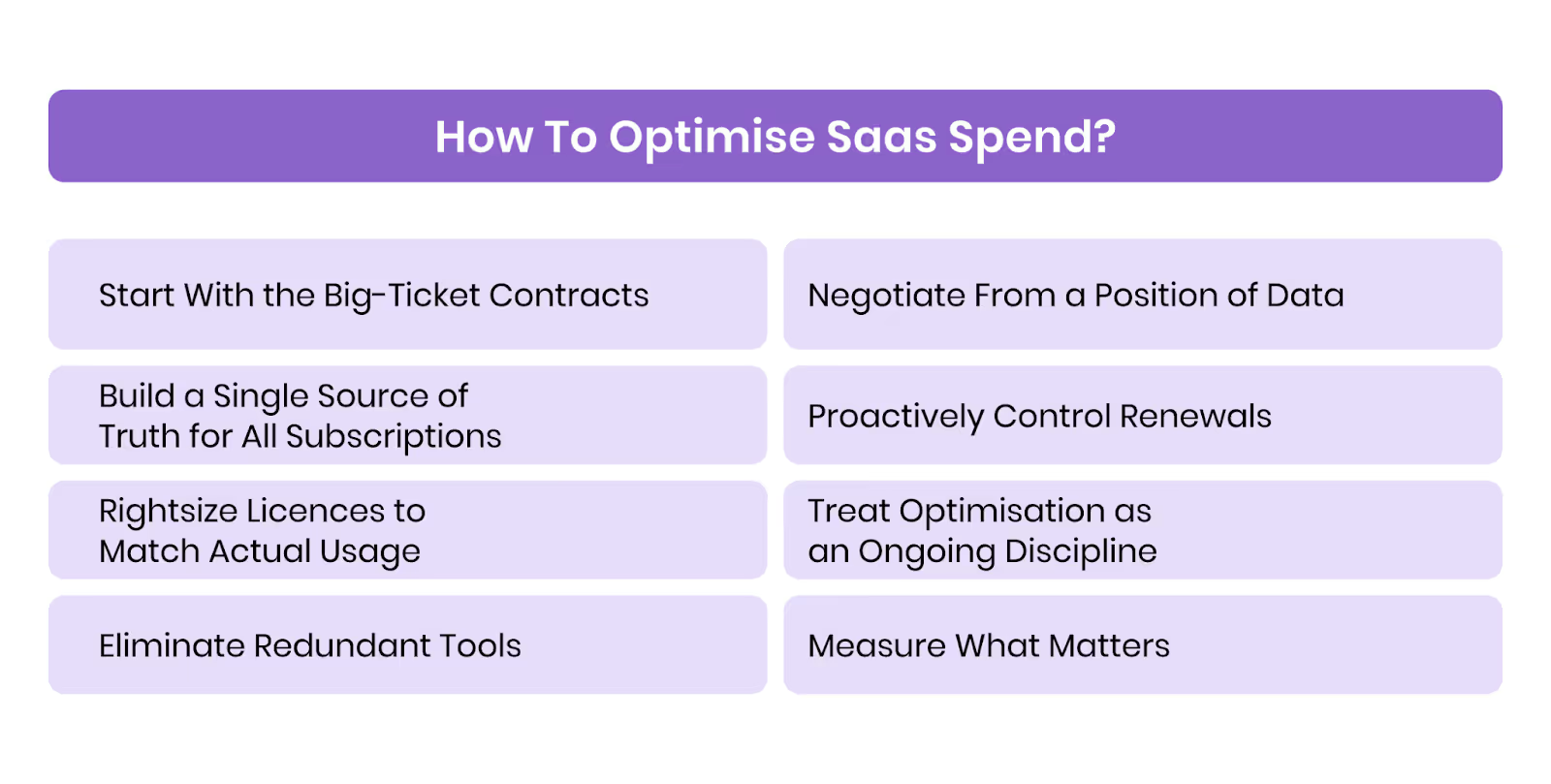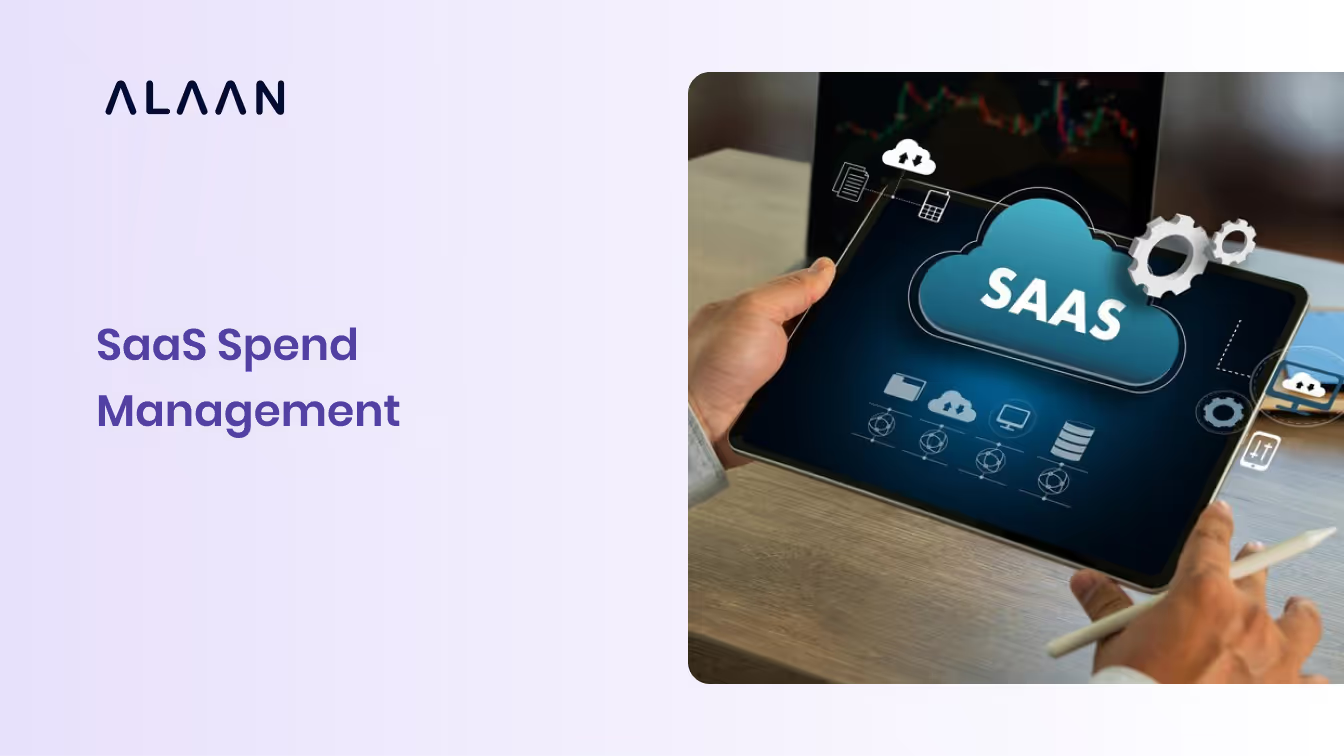In 2023, the UAE’s SaaS segment accounted for 58% of the country’s public cloud revenue, making it the largest contributor to the country's cloud market and signaling the deep integration of software subscriptions into business operations.
Yet even in a quickly digitising market, uncontrolled SaaS subscriptions can become a stealth drain. Departments sign up for tools independently, licenses lie dormant, and renewals slip through the cracks. What begins as a smart, agile move can morph into a fragmented, costly maze.
For growing firms, SaaS spend can quickly spiral. This guide highlights the risks of neglecting it and outlines proven methods to keep costs aligned with growth goals.
Key Takeaways
- Why SaaS Spend Management Matters – Without visibility, SaaS costs spiral through hidden renewals, unused licences, and compliance risks that distort budgets and weaken forecasting.
- Common Challenges – Shadow IT, unused licences, duplicate tools, complex vendor pricing, and VAT risks make SaaS spend harder to manage than other expense categories.
- Optimisation Framework – Discover and inventory subscriptions, rightsize licences, consolidate vendors, centralise procurement, map SaaS into finance workflows, manage renewals proactively, and monitor KPIs.
- Technology’s Role – Corporate card controls, AI-driven compliance checks, and real-time dashboards streamline reconciliation, prevent overspend, and ensure VAT audit readiness.
- KPIs to Track – Licence utilisation, spend per employee, redundant app count, vendor concentration, and VAT compliance rate provide clear signals of optimisation success.
Saas Spend Management as a Finance Discipline
SaaS spend management is not merely a software inventory exercise. It is financial governance applied to a high-velocity, recurring expense category: the discipline of ensuring every subscription delivers measurable value, is paid through approved flows, and is recorded in the books with audit-grade evidence.
Core outcomes that matter to finance are:
- Predictable cash outflows (renewal visibility and accruals).
- Clean audit trails (VAT/TRN capture and invoice linkage).
- Actionable cost-to-value data (usage vs cost per licence).
Illustrative Scenario: UAE FinTech’s SaaS Spend Control Journey
A Dubai-headquartered FinTech firm operating across the UAE mainland, Abu Dhabi free zones, and the broader GCC faced fragmented SaaS purchasing across multiple business units.
Each office procured tools independently, some via local cards, others through foreign billing, leading to cash surprises and reconciliation challenges. During a UAE VAT audit, the finance team struggled to match vendor invoices with actual service usage, resulting in gaps in audit compliance.
To address this, they instituted a SaaS governance initiative:
- Unified spend visibility: They aggregated SaaS expenses across all entities (UAE mainland, ADGM, KSA) into a consolidated dashboard
- Usage-based license cleanup: By correlating usage logs, they flagged dormant accounts and reclaimed approximately 20 % of unused licenses
- Renewal forecasting & accruals: An 18-month projection of SaaS cash requirements (AED/USD/SAR) was established and integrated into monthly cash planning
- Approval gates tied to cost value: Any new subscription or renewal above a threshold requires a finance sign-off, with justification based on usage metrics and cost per active user
Outcomes:
They reversed unnecessary spending amounting to several hundred thousand AED. The forward forecast eliminated surprise renewals. And in a mock VAT audit, they demonstrated full traceability: invoice → TRN → internal approval → usage logs → recorded expense. With governance now in place, the firm could move on to optimization, such as renegotiation, consolidation, and cost allocation across entities.
To use these outcomes strategically, it helps to differentiate management from optimisation. Let’s understand.
SaaS Spend Management vs SaaS Spend Optimisation
Management is equal to governance. It covers the lifecycle: discovery, procurement policy, ownership, renewal workflows, and compliance.
Optimisation is equal to efficiency. It focuses on rightsizing, vendor rationalisation, pricing negotiation, and continuous savings.
Both are required: governance prevents new waste, while optimisation recovers value from existing waste. Finance teams typically lead on management and sponsor optimisation because both directly affect forecasts, audit-readiness, and the ability to redeploy savings.
Understanding that distinction, let us examine why this spending category deserves priority today.
Reasons SaaS Spend Management Should Be on Every CFO’s Radar

SaaS has become one of the fastest-growing categories of business expenses. Left unmanaged, it leads to surprise renewals, unused licences, VAT compliance risks, and poor forecasting. A structured approach to SaaS spend equips CFOs with real-time visibility and stronger cost control, transforming a potential liability into an opportunity for efficiency and scalability.
1. Rising Cost Without Visibility
Software subscriptions often start small, but as teams expand, spend scales quickly across multiple licences and vendors. Without central visibility, CFOs are left with surprise renewals or budget overruns that were never approved at leadership level.
With corporate cards linked to spend dashboards, they can see every SaaS charge in real time and prevent overspend before it hits the books.
2. Wasted Budgets from Unused Licences
Studies show nearly half of software licences go unused, meaning companies pay for tools that deliver no value. This wasted spending eats into budgets that could otherwise support growth initiatives or operational improvements.
Automated expense tracking flags underused subscriptions, allowing finance teams to cut or reallocate spend with confidence.
3. Compliance and Audit Headaches
In the UAE and KSA, SaaS vendors must provide VAT-compliant invoices. When invoices are missing or incomplete, finance teams face the dual risk of losing input VAT claims and failing audit checks. Managing this manually across dozens of vendors is error-prone and time-consuming.
Platforms with AI-driven compliance checks automatically validate VAT fields (like TRN numbers) and keep every invoice audit-ready.
4. Forecasting and Cash Flow Pressure
Recurring SaaS payments often renew silently in the background, making it harder to forecast monthly outflows accurately. This erodes confidence in financial planning and complicates cash flow management.
Centralised dashboards and automated reconciliation with platforms like Alaan provide clarity over future commitments, ensuring budget planning with precision.
[cta-4]
Fixing these problems requires clear ownership and accountability.
Who Should Own Saas Spend (and Why Ownership Matters)
Ownership is often diffuse; procurement, IT, finance and business units all play a part. That diffusion is the root cause of fragmentation. To stop leakage, assign two things clearly:
- Financial ownership (anchor): Finance owns the governance framework, budgets, approval thresholds, reporting and accruals.
- Operational ownership (stewards): IT and business unit heads own application health, licensing needs and user adoption.
A simple decision rule helps: finance approves the funds and enforces payment rails; business owners justify the license and measure usage. This split preserves agility while giving finance the control it needs.
With clear ownership, the common challenges become solvable rather than inevitable.
Common Challenges in Saas Spend Management

SaaS adoption has become essential for growth, but managing the financial side of it is anything but straightforward. There are recurring obstacles that make SaaS spend harder to control than other categories of expense.
1. Shadow It and Untracked Subscriptions
Departments often sign up for tools directly using reimbursements. These hidden subscriptions bypass procurement and finance controls, creating blind spots in spend reporting.
When all SaaS purchases are routed through central corporate cards with spend limits, it gives visibility into every vendor charge, even those initiated by individual teams.
2. Overprovisioned and Unused Licences
Without active monitoring, companies pay for far more licences than employees actually use. For CFOs, this means budgets tied up in software that adds no value, a drain on both cash flow and ROI.
3. Overlapping and Duplicate Tools
Multiple teams often purchase different SaaS products with similar features. This creates duplication, drives up vendor counts, and weakens negotiation power with suppliers.
Centralised spend dashboards highlight overlapping vendors, enabling finance and procurement to consolidate contracts and secure better terms.
4. Complex Pricing and Renewal Models
SaaS vendors frequently use tiered or usage-based pricing that is hard to forecast. Renewals often auto-charge without warning, leading to budget surprises and rushed approvals.
5. Compliance and VAT Risks
In markets like the UAE and KSA, SaaS invoices must meet VAT requirements. Missing TRNs or incomplete invoices expose companies to compliance risks and lost input VAT claims. Managing this across multiple vendors manually is resource-intensive.
AI-powered expense management platforms like Alaan automatically validate VAT fields, ensuring every SaaS payment is compliant and audit-ready. With Alaan, you can get clear visibility of your company’s expenses on one dashboard.
[cta-6]
How to Optimise Saas Spend?

Uncontrolled subscriptions don’t fix themselves. It needs a structured framework that addresses the full SaaS lifecycle, from discovery to renewal, while making optimisation an ongoing discipline, not a one-off project.
Here’s a practical roadmap:
1. Start With the Big-Ticket Contracts
Not all SaaS spend is equal. A handful of enterprise tools often consume the bulk of budgets. Prioritising these high-cost subscriptions for review delivers faster savings and sets the tone for disciplined vendor management.
2. Build a Single Source of Truth for All Subscriptions
Fragmented purchasing hides the real cost of SaaS. Create a centralised inventory that captures every subscription, cost, owner, and renewal date. This becomes the foundation for all optimisation decisions.
3. Rightsize Licences to Match Actual Usage
Unused or underused licences drain budgets quietly. Tracking logins and adoption helps identify seats that can be downgraded, reallocated, or cancelled, ensuring you only pay for what’s genuinely needed.
4. Eliminate Redundant Tools and Purchasing Channels
Multiple apps often perform the same function across teams. In parallel, subscriptions may be bought through AP, cards, and reimbursements, fragmenting costs and weakening leverage. Consolidation here cuts waste and simplifies oversight.
5. Negotiate From a Position of Data
Vendors respond to evidence. Usage reports and market benchmarks strengthen negotiation power, unlocking better discounts, contract flexibility, or credits. Data-driven negotiations ensure pricing reflects real value delivered.
6. Proactively Control Renewals
Renewals are leverage points, but only if approached early. Setting alerts well ahead of contract dates avoids rushed approvals and ensures renegotiation opportunities aren’t lost to auto-renewals.
7. Treat Optimisation as an Ongoing Discipline
SaaS spend isn’t static. Usage patterns shift as teams scale and priorities evolve. Continuous monitoring of utilisation trends and vendor overlaps ensures cost control stays relevant over time.
8. Measure What Matters
Licence utilisation rates, reclaimed spend, vendor concentration, VAT compliance, and forecast accuracy are the KPIs that reveal whether SaaS spend is being truly optimised or just moved around.
Alaan combines expense automation with corporate cards, making these steps easier to execute.
Suggested Read: Cash Flow Optimisation Strategies for UAE Businesses in 2025
Take Control of SaaS Spend and Costs with Alaan
Managing SaaS subscriptions does not have to mean chasing invoices, battling hidden renewals, or discovering wasted licences months too late. At Alaan, we give the visibility and control you need, without slowing teams down.
- Corporate card controls ensure every subscription is tied to a central card, with spend limits, vendor locks, and instant blocking when needed.
- AI-powered expense management automatically matches invoices to transactions, flags anomalies, and keeps every SaaS payment VAT-compliant.
- Real-time dashboards provide with a single view of all subscriptions, renewal dates, and vendor costs, no more fragmented spreadsheets.
The outcome is simple: no more surprise renewals, no wasted licences, and no audit stress. Instead, your SaaS spend becomes predictable, transparent, and aligned with business priorities. That is why businesses rely on us as the No. 1 expense management platform in the Middle East, rating us 4.7 on G2.
Conclusion
SaaS subscriptions are now core to how companies operate, but without discipline, they quickly become uncontrolled spend. Finance leaders face the brunt of this, from unused licences draining budgets to VAT gaps creating audit risks. What should be a strategic enabler often turns into a recurring headache.
The difference lies in how SaaS spend is managed. With structured frameworks and the right tools, subscriptions can move from hidden costs to controlled, optimised investments.
At Alaan, we make this possible. Our corporate cards and AI-powered expense management platform give finance teams real-time control over every SaaS payment, from vendor-level visibility to seamless reconciliation. The result: less waste, more accuracy, and stronger financial control.
Schedule a demo to see how Alaan can simplify SaaS spend for your business.
Frequently Asked Questions
1. Why is SaaS spend management important for finance leaders?
Because SaaS subscriptions are recurring costs that compound silently. Without visibility, they lead to budget overruns, duplicate tools, and compliance risks, all of which directly affect financial control.
2. What’s the biggest driver of wasted SaaS spend?
Unused licences and duplicate subscriptions across departments. These often go unnoticed because renewals are automated and payments are fragmented across different cards or accounts.
3. How does SaaS spend management improve compliance in the UAE and KSA?
By ensuring all vendor invoices meet VAT requirements (correct TRN, tax breakdown, and categorisation). Automated expense systems validate this information, protecting VAT claims and making audits smoother.
4. How can finance leaders forecast SaaS costs more accurately?
By linking recurring subscription payments directly into central dashboards and ERP systems. This provides real-time visibility of renewals and future commitments, improving cash flow planning.
5. Can SaaS spend be controlled without slowing teams down?
Yes. With role-based corporate card controls and automated approvals, employees still access the tools they need, while finance retains visibility and control over recurring spend.


.avif)







%201.avif)